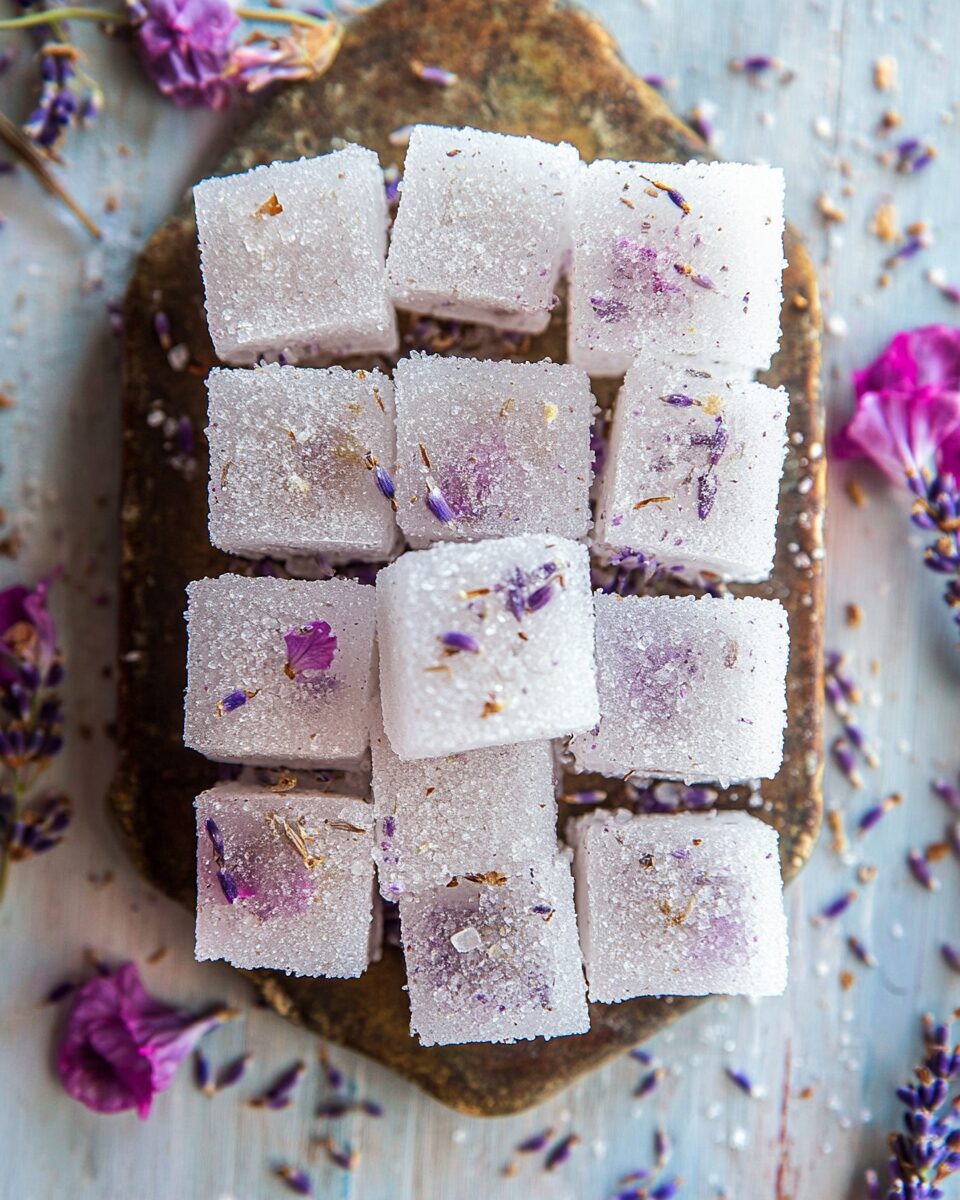Making homemade sugar cubes is a fun and simple way to add a personalized touch to your beverages. With just a few ingredients and minimal effort, you can create beautifully shaped sugar cubes perfect for tea parties, coffee breaks, or simply sweetening your drinks.
FULL RECIPE
Ingredients
- 1 cup granulated sugar
- 1 tablespoon water
- Optional: flavoring (e.g., vanilla extract, cinnamon, or lemon zest)
Directions
- In a small bowl, combine the granulated sugar and water.
- Mix well until the sugar is moistened and resembles wet sand.
- If desired, add a few drops of your preferred flavoring and mix to combine.
- Press the sugar mixture into a silicone mold or ice cube tray.
- Let the sugar cubes dry at room temperature for several hours, or overnight, until hard.
- Once dried, remove the sugar cubes from the mold and store them in an airtight container.
Nutritional Information
- Calories: 20 per cube
- Total fat: 0g
- Sodium: 0mg
- Carbohydrates: 5g
- Sugars: 5g
- Protein: 0g
The Role of Water in Sugar Cube Formation
Water is a key ingredient in sugar cube formation. When mixed with sugar, the water dissolves just enough sugar to make it pliable. The mixture retains its granules, which then bond together, creating a solid cube as the water evaporates. This interaction between sugar and water is crucial for the cubes to take shape and harden.
Choosing the Right Sugar
Granulated sugar is typically the best option for making sugar cubes. However, other types of sugar, such as caster sugar or raw sugar, can be used depending on the desired texture. Each sugar variety can subtly change the look and taste of the final cubes. Choosing the right sugar is important, especially if you’re looking for a specific texture or flavor.
The Mold for Sugar Cubes
Molds are essential for shaping sugar cubes. Silicone molds are popular because they are flexible, making it easier to remove the hardened cubes without damaging them. Ice cube trays also work well for smaller cubes. For more intricate designs, specialized sugar cube molds are available, which can give your cubes a unique appearance. The mold size and shape directly influence the final look of the cubes.
Flavoring Sugar Cubes
Flavoring sugar cubes opens up many creative possibilities. A few drops of extracts like vanilla, almond, or lemon can add a personalized touch. For more adventurous flavors, try adding mint, cinnamon, or even edible flowers. Flavoring sugar cubes not only changes their taste but also adds visual appeal, making them a great option for special occasions.
Coloring Sugar Cubes
Coloring sugar cubes is an easy way to make them visually striking. Food coloring can be added to the sugar-water mixture to achieve vibrant hues. Whether you’re preparing sugar cubes for a festive event or simply want to brighten up your drinks, coloring them adds a playful element. Be sure to use food-safe coloring to ensure the cubes remain safe to consume.
Drying Time for Sugar Cubes
The drying time for sugar cubes is crucial to their texture. Generally, sugar cubes need several hours to dry completely, and it’s often best to leave them overnight. As they dry, the moisture evaporates, and the sugar crystallizes, forming solid cubes. The drying process plays a major role in achieving the desired firmness and shape.
Humidity and Sugar Cube Drying
Humidity affects the drying time of sugar cubes. High humidity can slow down evaporation, making the drying process take longer. Conversely, low humidity may cause the cubes to dry too quickly, which can result in cracks or a brittle texture. A moderate humidity level is ideal for achieving well-formed sugar cubes.
Sugar Cube Storage
Once sugar cubes have dried fully, it’s important to store them properly to maintain their freshness. To prevent them from absorbing moisture from the air, store them in an airtight container. Sugar cubes should be kept in a cool, dry place, where they will stay fresh for several weeks. If you’ve added flavorings or colors, it’s best to store them separately to prevent any mixing of flavors.
Creative Uses for Sugar Cubes
Sugar cubes aren’t just for sweetening drinks. They can be used in various creative ways. For instance, you can place them in decorative jars as part of a table setting or sprinkle them on baked goods like muffins and cakes. They can also be melted down for use in cocktails or used as garnishes. Their versatility makes sugar cubes a fun and useful ingredient in many culinary applications.
Sugar Cubes as Party Favors
Sugar cubes make excellent party favors. By shaping them in different colors and sizes, you can create personalized gifts for guests at weddings, holidays, or any celebration. Adding a special message or creating unique designs adds a thoughtful touch to the favor. Packaged in cute jars or bags, they also make a charming addition to any event.
The History of Sugar Cubes
The sugar cube has a fascinating history. Before the invention of sugar cubes, sugar was sold in large blocks that had to be broken down manually. The sugar cube, as we know it today, was invented in Switzerland in the 1840s to make handling sugar easier. Over time, sugar cubes became widely popular for their convenience and precise portions.
The Science Behind Sugar Cube Formation
The process of crystallization is at the heart of sugar cube formation. When sugar is mixed with water, the sugar dissolves and forms a liquid solution. As the solution dries, the water evaporates, and the sugar crystals bond together, forming solid cubes. The drying conditions, such as temperature and humidity, influence the crystallization process and affect the texture of the cubes.
Sustainable Sugar Cube Production
Sustainability is becoming increasingly important in sugar cube production. Many people are looking for ways to reduce their environmental impact by using organic sugar or reducing packaging waste. By choosing sustainable ingredients and production methods, sugar cubes can be made in a more eco-friendly way. This shift reflects a growing desire to create products that align with environmentally conscious values.
The Popularity of Flavored Sugar Cubes
Flavored sugar cubes have surged in popularity due to their ability to elevate beverages. These cubes can be infused with a wide range of flavors, from classic vanilla to more exotic choices like lavender or rose. They offer a convenient way to add an extra layer of flavor to tea, coffee, or even cocktails. Their customizable nature makes them a fun and trendy option for beverage enthusiasts.
Sugar Cubes in Cocktails
Sugar cubes are a staple in many cocktails, particularly those that require precise sweetening. They dissolve easily in liquids, making them a quick and efficient way to sweeten drinks. Classic cocktails like the Old Fashioned and Mojito often feature sugar cubes. For a creative twist, flavored sugar cubes can be used to add a unique flavor profile to your cocktails.
The Role of Sugar Cubes in Tea Culture
In many cultures, particularly in England and Japan, sugar cubes are an essential part of tea service. They provide a convenient and mess-free way to sweeten tea without affecting the drink’s delicate flavors. The use of sugar cubes in tea is also ceremonial, often served in decorative dishes alongside the tea. In these traditions, sugar cubes represent both simplicity and elegance.
Conclusion
Sugar cubes are a fun and versatile ingredient that can be enjoyed in many different ways. From sweetening beverages to being used as decorative items or baked goods, sugar cubes bring a personal touch to any culinary creation. Whether experimenting with flavors, shapes, or colors, making sugar cubes offers endless opportunities for creativity.






